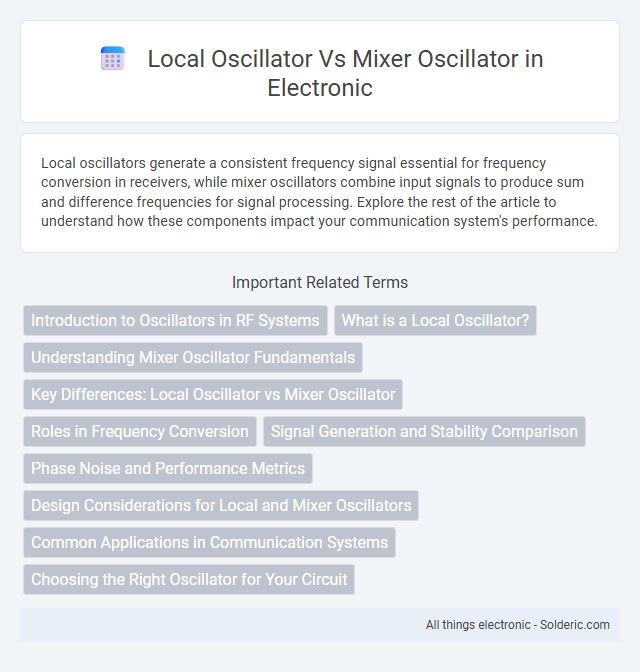Local oscillators generate a consistent frequency signal essential for frequency conversion in receivers, while mixer oscillators combine input signals to produce sum and difference frequencies for signal processing. Explore the rest of the article to understand how these components impact your communication system's performance.
Comparison Table
| Feature | Local Oscillator | Mixer Oscillator |
|---|---|---|
| Function | Generates a stable frequency signal for frequency conversion | Combines signals to produce sum and difference frequencies |
| Frequency Stability | High stability for accurate tuning | Depends on mixer and input signals |
| Role in Radio Receiver | Provides reference frequency for mixing | Mixes input RF and local oscillator signals |
| Output | Single frequency output | Multiple frequencies (sum and difference) |
| Type of Signal | Sinusoidal, stable frequency | Combined signals, non-linear output |
| Implementation | Oscillator circuit (e.g., crystal, LC) | Mixer circuit (diode, transistor-based) |
Introduction to Oscillators in RF Systems
Oscillators in RF systems generate stable frequency signals essential for signal processing and communication. A local oscillator produces a fixed frequency used to mix with incoming signals in superheterodyne receivers, enabling frequency translation, while a mixer oscillator is part of the mixing process itself, combining frequencies to create intermediate frequencies. Understanding the differences between local oscillators and mixer oscillators is crucial for optimizing your RF system's performance and signal clarity.
What is a Local Oscillator?
A Local Oscillator (LO) generates a stable frequency signal used in frequency conversion processes within radio receivers and transmitters. It combines with the incoming signal in a mixer to produce an intermediate frequency (IF) for easier processing. The LO frequency is carefully controlled to ensure accurate tuning and signal demodulation efficiency.
Understanding Mixer Oscillator Fundamentals
Mixer oscillators generate a stable frequency used to convert signals in frequency mixing processes, critical for applications like RF communication and signal processing. Local oscillators provide a reference frequency to mixers that combine input signals with the local oscillator tone, enabling frequency translation. Understanding mixer oscillator fundamentals involves analyzing signal stability, phase noise, and conversion efficiency for optimized performance in mixers.
Key Differences: Local Oscillator vs Mixer Oscillator
A local oscillator generates a stable frequency signal used to convert incoming signals to intermediate frequencies in superheterodyne receivers, ensuring precise frequency translation. Mixer oscillators combine the functions of a local oscillator and a mixer by generating oscillations while simultaneously mixing input signals, simplifying circuit design and reducing component count. Key differences include their roles in frequency generation and signal mixing, with local oscillators focusing solely on stable frequency output, whereas mixer oscillators handle both oscillation and mixing processes.
Roles in Frequency Conversion
The local oscillator generates a stable frequency signal that mixes with the input signal in the mixer oscillator to produce new frequencies, crucial for frequency conversion in radio receivers. The mixer oscillator combines the local oscillator signal and the input signal, creating sum and difference frequencies, enabling shifts from high to intermediate or baseband frequencies. This frequency conversion process enhances signal processing by allowing easier filtering and amplification at lower frequencies.
Signal Generation and Stability Comparison
Local oscillators generate stable, fixed-frequency signals crucial for consistent frequency conversion in receivers, exhibiting superior phase noise performance and frequency stability compared to mixer oscillators. Mixer oscillators combine mixing and oscillation functions but typically suffer from less frequency stability and higher signal distortion due to the dual-role operation. The enhanced stability of local oscillators supports accurate signal demodulation, whereas mixer oscillators are suited for applications where compactness outweighs precision.
Phase Noise and Performance Metrics
Local oscillators typically exhibit lower phase noise compared to mixer oscillators, making them superior for applications requiring high signal purity and stability. Performance metrics such as phase jitter, frequency stability, and spectral purity heavily favor local oscillators due to their well-controlled design and isolation from mixing artifacts. In contrast, mixer oscillators often introduce additional phase noise and spurious signals, negatively impacting overall system performance in sensitive RF and microwave communication systems.
Design Considerations for Local and Mixer Oscillators
Design considerations for local oscillators emphasize frequency stability, phase noise reduction, and spectral purity to ensure accurate frequency conversion in RF applications. Mixer oscillators require optimized amplitude control, injection locking, and impedance matching to maintain effective signal mixing without introducing distortion or excessive noise. Both oscillators demand careful selection of components and circuit topologies to balance power consumption, tuning range, and integration with the overall system.
Common Applications in Communication Systems
Local oscillators are commonly used in communication systems for frequency synthesis, providing stable reference signals crucial for signal modulation and demodulation. Mixer oscillators play a key role in frequency conversion processes such as upconversion and downconversion, enabling the effective transmission and reception of signals across different frequency bands. Your communication device relies on these oscillators to maintain signal integrity and optimize performance in applications like radios, televisions, and wireless networks.
Choosing the Right Oscillator for Your Circuit
Choosing the right oscillator for your circuit depends on the specific application requirements and signal characteristics. Local oscillators provide stable frequency references essential for frequency conversion in communication systems, while mixer oscillators combine oscillation and mixing functions for compactness and efficiency in RF circuits. Understanding your circuit's frequency stability, phase noise, and integration needs will help you select an oscillator that optimizes performance and reliability.
Local oscillator vs Mixer oscillator Infographic

 solderic.com
solderic.com